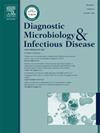Antibiotic resistance and bacterial spectrum in cerebrospial fluid cultures: Initial insights from Pakistan
IF 1.8
4区 医学
Q3 INFECTIOUS DISEASES
Diagnostic microbiology and infectious disease
Pub Date : 2025-04-15
DOI:10.1016/j.diagmicrobio.2025.116847
引用次数: 0
Abstract
Antimicrobial resistance (AMR) is a rising global health concern, especially in resource-limited countries like Pakistan, where indiscriminate and unregulated use of antibiotics has significantly worsened this problem. The study aimed to analyze the bacterial spectrum and antimicrobial resistance patterns in cerebrospinal fluid (CSF) cultures from patients with suspected bacterial meningitis, providing crucial insights for better infection control and treatment strategies.This retrospective study analyzed 1107CSF cultures were between 2019 and 2024 at the Lady Reading Hospital, MTI, Khyber Pakhtunkhwa, Pakistan, to assess bacterial profiles in patients with suspected bacterial meningitis and investigate the AMR patterns. Among the 106 positive growth cultures, gram-negative bacteria accounted for 84.9 %. Alarmingly, Acinetobacter baumannii was found to be completely resistant to all the nine antibiotics tested, while Salmonella typhi showed resistance to six out of seven tested antibiotics, highlighting their severe multi-drug resistance profile. Moreover, notable resistance was observed in Citrobacter freundii, Enterobacter species, and Staphylococcus aureus. The distribution results indicated that the Klebsiella pneumoniae is more prevalent in males and the 1–13 years age group. These findings highlight the necessity for urgent action on antibiotic stewardship, improved surveillance, and public awareness to mitigate the spread of AMR pathogens, particularly in life-threatening infections such as bacterial meningitis. Strengthening infection control measures and regulating antibiotic usage policies is imperative to curb the growing AMR crisis.
脑脊液培养中的抗生素耐药性和细菌谱:来自巴基斯坦的初步见解
抗菌素耐药性(AMR)是一个日益严重的全球卫生问题,特别是在巴基斯坦等资源有限的国家,不加选择地和不受管制地使用抗生素大大加剧了这一问题。该研究旨在分析疑似细菌性脑膜炎患者脑脊液(CSF)培养物中的细菌谱和抗微生物药物耐药性模式,为更好的感染控制和治疗策略提供重要见解。本回顾性研究分析了2019年至2024年期间在巴基斯坦开伯尔-普赫图赫瓦省MTI的Lady Reading医院进行的1107例脑脊液培养,以评估疑似细菌性脑膜炎患者的细菌谱并调查AMR模式。106株阳性培养物中革兰氏阴性菌占84.9%。令人震惊的是,鲍曼不动杆菌被发现对所有测试的9种抗生素完全耐药,而伤寒沙门氏菌对7种测试的抗生素中的6种耐药,突出了它们严重的多药耐药情况。此外,在弗氏柠檬酸杆菌、肠杆菌和金黄色葡萄球菌中观察到明显的耐药性。分布结果表明,肺炎克雷伯菌以男性和1 ~ 13岁年龄组多见。这些发现强调必须在抗生素管理、改进监测和提高公众意识方面采取紧急行动,以减轻抗菌素耐药性病原体的传播,特别是在细菌性脑膜炎等危及生命的感染中。加强感染控制措施和规范抗生素使用政策对于遏制日益严重的抗生素耐药性危机至关重要。
本文章由计算机程序翻译,如有差异,请以英文原文为准。
求助全文
约1分钟内获得全文
求助全文
来源期刊
CiteScore
5.30
自引率
3.40%
发文量
149
审稿时长
56 days
期刊介绍:
Diagnostic Microbiology and Infectious Disease keeps you informed of the latest developments in clinical microbiology and the diagnosis and treatment of infectious diseases. Packed with rigorously peer-reviewed articles and studies in bacteriology, immunology, immunoserology, infectious diseases, mycology, parasitology, and virology, the journal examines new procedures, unusual cases, controversial issues, and important new literature. Diagnostic Microbiology and Infectious Disease distinguished independent editorial board, consisting of experts from many medical specialties, ensures you extensive and authoritative coverage.

 求助内容:
求助内容: 应助结果提醒方式:
应助结果提醒方式:


